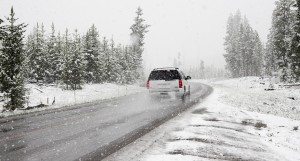 Winter driving in New England is challenging at best. Snow, freezing temperatures and less-than-ideal temperatures can make getting to and from your destination a nightmare. When road conditions are dangerous, the best piece of advice for drivers is to simply stay home. Driving during a snowstorm not only puts your safety at risk, but also that of your passengers and other drivers on the road.
Winter driving in New England is challenging at best. Snow, freezing temperatures and less-than-ideal temperatures can make getting to and from your destination a nightmare. When road conditions are dangerous, the best piece of advice for drivers is to simply stay home. Driving during a snowstorm not only puts your safety at risk, but also that of your passengers and other drivers on the road.
Sometimes, however, situations arise where you must drive during a winter storm. Perhaps a family member falls ill and you need to meet them at a hospital. Or maybe you need to commute to work and have to other means of transportation. There are also times when the weather can seem relatively harmless upon your departure, but quickly worsens and eventually becomes life-threatening. It is fairly well-known that weather forecasts are not always 100% accurate, and winter conditions can quickly change – especially in New England. In the unexpected event that you are caught in a snowstorm, and the conditions are so poor that driving becomes impossible, there are a few pieces of advice that will help you and your passengers make it through the scary situation.
Keep Friends and Family Posted
If you are forced to travel in inclement weather, the first thing that you should do is let your friends and family know when you have departed, and your estimated time of arrival. In a perfect world, road conditions would always be flawless and cell phone batteries would never die. Of course, this is far from the world we live in. By keeping your loved ones in the loop, they will suspect something is afoul if hours pass after your ETA, and can contact the local police department for help.
Of course, also be sure to use your own phone to call for help as soon as you need it, and stay on the line with the other person as long as necessary. Describe where you are pulled over and be descriptive as possible – include the nearest highway exit (if known) as well as any recognizable landmarks or points-of-interest.
Pack an Emergency Kit
Although you should always have an emergency kit present in your vehicle in New England, such is especially important in the wintertime. Your emergency car kit should include, at the very least:
- Blankets and sleeping bag
- Bottled water
- Flashlight and batteries
- Shovel and scraper
- Non-perishable food
- Flares
- Whistle/other attention-grabbing device
- First aid kit
- Jumper cables
- Winter hats, socks and gloves
Unfortunately, in the event that you are stuck in a snowstorm, there is no telling how long you may be stuck inside your vehicle, so it’s best to come prepared with any essentials you may need.
Don’t Move!
A common mistake that many drivers make is exiting their vehicles to call for help. Plain and simple: don’t, unless help (gas station, etc.) is in eyesight! Exiting your vehicle not only exposes you to dangerously-cold temperatures, but very often, people who try to find help become disoriented by blizzard conditions.
Although you may think you know where you’re going, once you exit you vehicle, you are truly risking your life. Gusting winds and whiteout conditions can cause you to become lost and disoriented very quickly. Stay in your vehicle with your hazard lights flashing, and only exit if you need to shovel off your vehicle, release flares, or flag down a passing vehicle. Have confidence that you will make it through the situation and realize that leaving to look for help only hurts your chances of doing so.
Use Your Heater Sparingly
Survival experts recommend conserving your car’s battery and fuel by only running the heating system in your vehicle every fifteen minutes or so. Run your heater just enough to feel comfortable – survival experts warn that it’s better to be slightly cold and alert than too warm and sleepy. During the latter scenario, you run the risk of not noticing impending dangers to your safety, such as an exhaust pipe being blocked causing dangerous fumes to enter your vehicle.
Remain Calm
Finally, and arguably most important of all, don’t panic. Panicking can cause you to make rash decisions that could inhibit your ability to make it through a life-threatening situation. Take a deep breath and make smart, calculated decisions. Survival experts claim that making it out of a dangerous situation is at least one half mental. If you’re stuck in your vehicle for a prolonged period of time, try to keep your mind as active as possible. If there are passengers present, make conversation to keep your brains active. Staying cool, calm and collected will help you survive an emergency situation and resume normal life.
